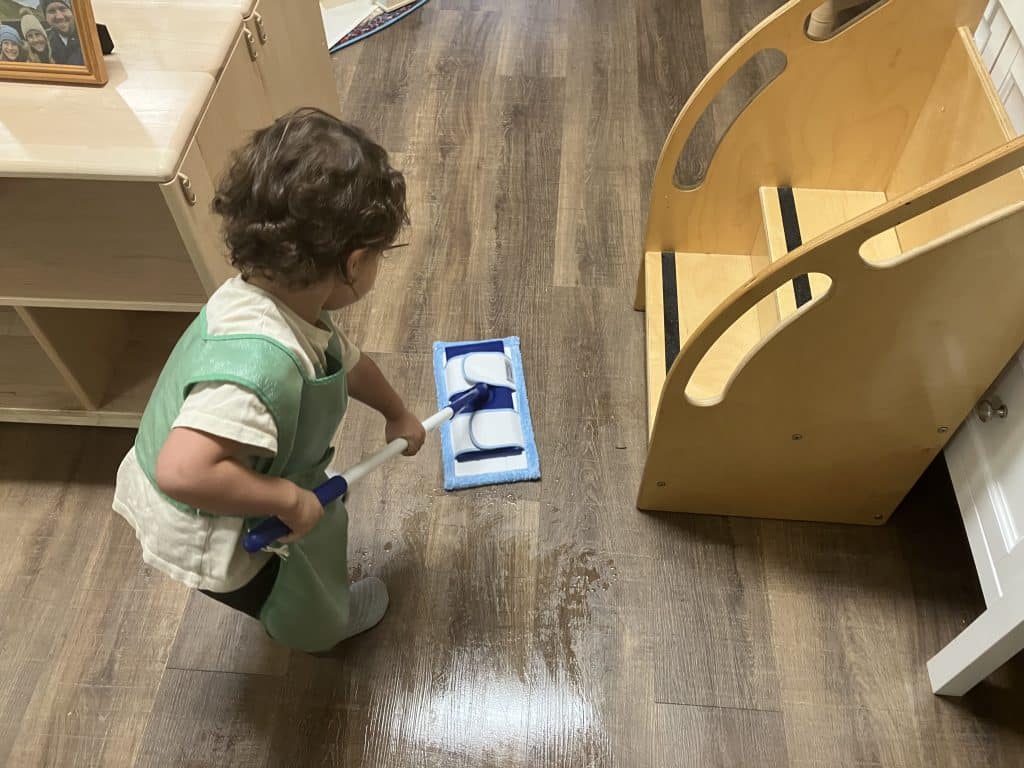In all the work in the Children’s House there is a benefit for developing the mathematical mind. From the sequential activities of practical life, the seriated and graded activities of sensorial, through the exploration of the mechanics of reading and writing, to the early work in geometry and arithmetic, the Children’s House experience lays a mathematical foundation for the elementary child.
Montessori stresses the importance of manipulating materials to discover answers, rather than merely memorizing math techniques. How much richer to arrange colored strips on a board to see the sum of two addends, instead of reading a flash card! It is fundamentally different to use your hands to compare fractional pieces, instead of just learning rules for comparing the numerator and the denominator. Who among us really understood why it worked to invert the denominator when dividing fractions? Our children do!
There are several reasons that Montessori math materials promote optimal intellectual development. First, multi-sensory learning allows students to use various parts of their brains to learn. Hands-on manipulations encourage active, discovery learning. Second, materials encourage children to work together, and these collaborations involve lots of discussion and rationalization. Third, Montessori students learn to strive for accuracy because the materials provide feedback. They see their math work as puzzles to be solved, instead of assignments to be completed. Finally, Montessori math materials are elegantly designed to use geometric relationships to show algebraic concepts.
The Young Mind is a Mathematical Mind
A great unconscious power is at work in the developing child which aids him in ordering his own impressions into relationships to create the foundation of his intellect. This earliest development of mathematical understanding is the work of the unconscious mind in classifying and categorizing perceptual impressions. What Dr. Montessori discovered was that young children have a mind that is mathematically inclined in its approach to ordering perceptions.
The mind of the young child not only makes inferences extracted from the physical world around them but also these impressions are generalized in the mind and go beyond physical reality. The process of the intellect creates abstractions based on inference. This action is the mathematical mind at work, creating concepts beyond reality and ordering them into relationships.
The understanding of the child’s mathematical mind plays a key role in the approach and curriculum in the Children’s House. Experiences are structured to appeal to the child’s natural urges to explore with his perceptions the immediate world of the here and now. Sensorial activities provide the opportunity to hone discrimination and appeal to the mathematical mind in their orderly isolation of sense experiences. This builds impressions which provide the grist for language to develop and express the abstractions of the physical properties the child has generalized from his experiences. As the child masters language he is able to manipulate symbols, and discovers the process of writing. This leads him to early understandings of the mechanics of reading.
“In our work we have given a name to this part of the mind which is built up with exactitude… we call it ‘the mathematical mind.’ I take the term from Pascal … who said that man’s mind was mathematical by nature, and that knowledge and progress come from accurate observation.”
Maria Montessori, The Absorbent Mind, (1949) Claude A. Claremont, trans. New York: Dell Publishing, 1967
Brain-based Learning
Montessori math constitutes superb brain-based learning. Robert Sylvester (A Biological Brain in a Cultural Classroom) states, “It is not the number of neurons itself that determines our mental characteristics; it is how they are connected;” and Eric Jensen (Teaching with the Brain in Mind), “The key to getting smarter is growing more synaptic connections between brain cells and not losing existing connections…The single best way to grow a better brain is through challenging problem solving.” Michael explains that unused connections are pruned, so the neurological rule is, “Use it or lose it.” All of this suggests that the best way to learn is to engage all the lobes of cerebrum, activating visual and auditory memory, along with controlled movement and problem-solving. Activities that cross hemispheres force interactions of logic and creativity. Take a look and you will see this built into the design of all Montessori learning materials.
The Children’s House
The key to this benefit lies in what Dr. Montessori called “materialized abstractions.” Her concrete hands-on materials present relationships for higher thinking later in life by creating impressions for abstraction. She observed that the hands are the tools of the mind, and provided for this natural activity in a systematic way. From spontaneous individual work the child gains what formal education could never teach later, the physical manipulation of abstract concepts.
As a Montessori parent be dissuaded from “helping” your child by teaching number tricks or doing lots of drills. These short cuts can short-circuit deeper learning. “Drill for skill” is great for parrots but not for children. Parents can trust the benefits of Montessori mathematics approach and the deeper understanding it develops. As a parent, avoid judging your child’s mathematics progress only by standardized test scores or the ability to answer correctly when quizzed. Let’s advocate for our children’s mathematical ability to run deep and evolve naturally with interest that is truly intrinsic.
We’d love to have you Schedule a Free Tour to experience how we guide children in the Children’s House, encourage active engagement, and support a life-long love of learning.




